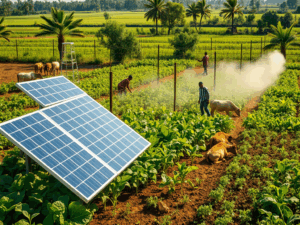
Agribusiness is a dynamic sector that holds immense potential for profitability and growth. However, one of the most daunting challenges faced by agripreneurs in Nigeria and across Africa is market price fluctuations. These fluctuations can wreak havoc on financial projections, disrupt supply chains, and threaten the viability of your business. Understanding how to handle these fluctuations effectively can make the difference between a thriving enterprise and a failed venture.
Understanding Market Price Fluctuations
Market price fluctuations are the changes in the price of agricultural products due to various factors. These can include weather conditions, changes in demand and supply, economic policies, and global market trends. For instance, a drought can reduce the supply of crops, leading to higher prices. Conversely, an unexpected bumper harvest can lead to a glut in the market, causing prices to plummet.
The Impact of Price Fluctuations on Agribusiness
Price fluctuations can have both positive and negative impacts on your agribusiness:
- Revenue Variability: Sudden drops in prices can lead to significant losses, especially if you’ve invested heavily in production. On the other hand, price spikes can increase your profits if you can meet the demand.
- Cost Management: Fluctuating prices affect the cost of inputs like seeds, fertilizers, and labor. High input costs can squeeze your profit margins.
- Market Uncertainty: Unpredictable prices create an unstable market environment, making it difficult to plan and forecast.
Strategies to Mitigate the Impact of Price Fluctuations
- Diversification: Diversification is a key strategy to cushion the effects of price fluctuations. By growing a variety of crops or integrating livestock farming, you spread the risk. When the price of one product drops, you may still have other profitable products to rely on.
- Value Addition: Adding value to your agricultural products can help you fetch better prices. For example, processing raw crops into finished products like flour, juice, or packaged snacks can significantly increase your profit margins. Value addition not only makes your products more appealing to consumers but also helps you differentiate in the market.
- Market Research and Forecasting: Staying informed about market trends and potential price shifts is crucial. Invest in market research and use forecasting tools to predict future price movements. This information can help you make informed decisions about planting, harvesting, and selling your products.
- Contract Farming: Engage in contract farming arrangements or off-taker agreements, where you agree to supply a certain quantity of produce to a buyer at a pre-agreed price. This provides a guaranteed market and price for your produce, protecting you from market volatility.
- Storage Facilities: Investing in proper storage facilities can help you avoid selling during periods of low prices. By storing your produce, you can wait for prices to rise before selling. This strategy requires an understanding of market dynamics and the ability to maintain product quality over time.
- Insurance and Financial Instruments: Explore agricultural insurance options that can protect you against losses due to price fluctuations and other risks like bad weather or pest infestations. Additionally, financial instruments such as futures contracts can help lock in prices and reduce uncertainty.
- Collaboration and Cooperatives: Joining or forming cooperatives can give you more bargaining power and better access to markets. Cooperatives can help in pooling resources for storage, marketing, and transportation, thereby reducing individual risks.
Real-Life Success Stories
1: Maize Farmers in Nigeria
A group of maize farmers in Kaduna, Nigeria, formed a cooperative to tackle price fluctuations. By collectively investing in a large storage facility and securing contracts with major buyers, they stabilized their income and even expanded their operations.
2: Cocoa Farmers in Ghana
In Ghana, cocoa farmers faced volatile market prices. Through diversification, some farmers started producing cocoa butter and powder, adding value to their raw produce. This move helped them secure better prices and build a more sustainable business model.
Conclusion
Handling market price fluctuations in agribusiness requires a strategic approach. By diversifying, adding value, staying informed, engaging in contract farming, investing in storage, leveraging insurance, and collaborating through cooperatives, you can mitigate the risks and ensure the sustainability of your agribusiness. Remember, the key to success lies in being proactive and adaptable. Equip yourself with the right knowledge and tools, and you will not only survive but thrive in the ever-changing agribusiness landscape.
This comprehensive guide provides valuable insights and actionable strategies to handle market price fluctuations, ensuring the resilience and profitability of your agribusiness. Implement these tips, and watch your agribusiness thrive even in the face of market uncertainties. Share this article with fellow agripreneurs and help build a more robust agricultural sector across Africa!



